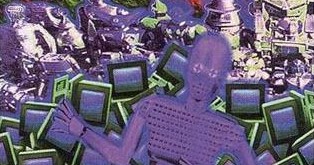|
[Close file]
Did You Know?
Bits and Pieces from the NR Trivia Collection
#9: Banpei
by Jens Kreutzer
with support by Nils Kreutzer and Daniel Schneider
Banpei is perhaps the most basic and typical of all sentry ice cards in the Corp's arsenal.
Because of its two "must-break" subroutines and its very reasonable rez cost, it is sometimes seen in Constructed play, and most players would use it in Sealed. Still, most sentry (and generic) icebreakers don't pay a lot to break through Banpei, although it seems to be the perfect foil for Big Frackin' Gun or Black Dahlia. Wild Card, of course, is a different story altogether.
The illustration on Banpei depicts a computerized, futuristic samurai in what seems to be a virtual hallway, standing guard. The warrior carries a sword strapped across his back, and his helmet has a shape typical of the Japanese kabuto. Incidentally, the original picture created by Douglas Shuler is only reproduced in part: On the cover of the Cyberpunk 2.0.2.0. supplement Bartmoss' Brainware Blowout, the whole illustration is depicted, showing another, similar samurai standing to the left of the one seen on the card.
Cyberpunk 2.0.2.0., published by R. Talsorian Games, is the roleplaying game from which the background of the Netrunner world was adapted. In the section on Netrunning in the Cyberpunk second edition basic rulebook (p. 139), an offensive program named "Killer" is mentioned, which is used to destroy other programs. Employed as a defense for dataforts as well as by Netrunners themselves, it comes in several strengths, just called "Killer II", "Killer IV", and so on, up to "Killer VI". Without doubt, this category of programs (which all do the same but have six different levels of strength in game terms) served as the model for Banpei, Ice Pick Willie, D'Arc Knight, Triggerman, Sentinels Prime, and Data Naga.
In the description of the icon (Netspace representation) that is characteristic of the "Killer" series, we find a "large manlike robot, dressed as a metallic samurai. His eyes glow red from behind his mask, and he carries a glowing katana" - et voila the Banpei illustration.
In the background as well as on the samurai's chest armor, one can see a stylized trefoil symbol, which is the corporate logo of Arasaka Corporation, based in Japan. This leaves no doubt about the Killer's affiliation. The red circle symbol divided into two drop-like halves with a white dot in them (seen right next to the samurai's elbow, and, by the way, on Loan From Chiba) is an ancient Asian symbol for Yin and Yang, two opposing forces representing the cosmos in Eastern philosophy, which are ideally in an equilibrium.
It is not too far-fetched to associate Yin and Yang with Bushido, the Way of the Warrior, which has its roots in Zen Buddhism and is mentioned in the card's flavor text. Bushido was a set of principles (theoretically) to be obeyed by the ideal warrior, among them absolute loyalty to one's lord, readiness to accept death in battle (or indeed at any given moment in life), and purity of mind. The quote, "The survival of Bushido into cyberspace has spiritual significance to many execs", finds its sequel in the flavor text of Wild Card, forming a nice connection between Banpei and its nemesis, thereby contrasting the Corporate philosophy of Bushido (yeah, right) with the Runner's more anarchistic approach.
Considering all of the above, the name "Banpei" couldn't be more fitting. As you might have guessed, banpei (pronounced [bahm-peh]) is
Japanese. Written with the Chinese characters for "guard" (ban) and "soldier" (hei, which becomes pei in this phonetic
environment), Banpei means just - "sentry".
[Previous Did You Know]
[Close file]
[Next Did You Know]
|
|
|

